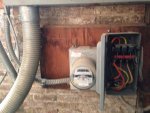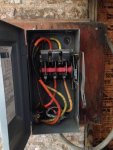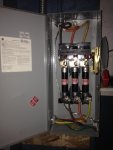I'm working in a building in an industrial park where there is 100amp 480v 3~ service being fed from a non-fused disconnect that is attached directly to the supply side of a meter, and is located within a "meter shed" about 150' away from the building I'm working in. The "meter shed" is being fed from a substation on the other side of the park where the utility comes in. The service is carried over for that 150' or so, from the non fused disconnect in the shed to a fused disconnect (fused at 90A) within the building I'm working in, via a 2-2-2-4 aluminum SER cable. The three insulated conductors are connected to the line terminals of the disconnect and the bare conductor is attached to a lug that is thru-bolted to the case of the disconnect.
Judging by the appearance of this service, it physically looks like it would be 3 wire 480 Delta, and the conductors are coded brown/orange/yellow like it's a Delta. When I put my volt meter on these conductors, i get approx. 480V between each of the three phases, however, I get approx. 277 volts from each phase to the bare conductor. It's my understanding that this would not be possible from a Delta configuration, but with a WYE configuration, there should be 4 insulated conductors and one bare EGC, thus the SER cable should be a 5C. I would not be at all surprised if the park owners had a 4C cable run to save $$$.
My question, is it possible that the bare conductor is being used as the neutral and as an EGC simultaneously? This sounds like it would be a violation and unsafe. Can this bare conductor carry current like in SEU cable in residential service? I've heard of situations like in MCC's where the supply is a 4W - WYE config. but only the three ungrounded conductors and an EGC are utilized and the neutral isn't pulled for cost savings. If that's the case here and the bare conductor is just an EGC, where is the reference back to the center point of the WYE coming from?
I've attached 3 pictures, 1 of the Meter/NF disconnect in the the meter shed, 1 closeup of the NF disconnect, and 1 of the Fused disconnect in the building.
Please enlighten me
Judging by the appearance of this service, it physically looks like it would be 3 wire 480 Delta, and the conductors are coded brown/orange/yellow like it's a Delta. When I put my volt meter on these conductors, i get approx. 480V between each of the three phases, however, I get approx. 277 volts from each phase to the bare conductor. It's my understanding that this would not be possible from a Delta configuration, but with a WYE configuration, there should be 4 insulated conductors and one bare EGC, thus the SER cable should be a 5C. I would not be at all surprised if the park owners had a 4C cable run to save $$$.
My question, is it possible that the bare conductor is being used as the neutral and as an EGC simultaneously? This sounds like it would be a violation and unsafe. Can this bare conductor carry current like in SEU cable in residential service? I've heard of situations like in MCC's where the supply is a 4W - WYE config. but only the three ungrounded conductors and an EGC are utilized and the neutral isn't pulled for cost savings. If that's the case here and the bare conductor is just an EGC, where is the reference back to the center point of the WYE coming from?
I've attached 3 pictures, 1 of the Meter/NF disconnect in the the meter shed, 1 closeup of the NF disconnect, and 1 of the Fused disconnect in the building.
Please enlighten me




